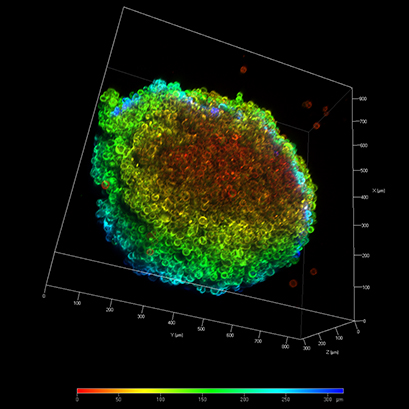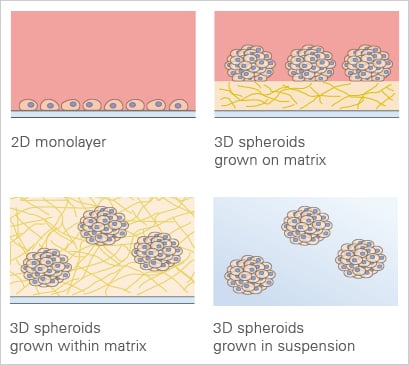3D Cell Culture
The majority of cells in living tissue grow in a three-dimensional microenvironment, where they communicate and interact with each other and their surroundings. Animal cells are embedded in the extracellular matrix (ECM), which is composed of proteoglycans and fibrous proteins (mainly collagen, elastin, and fibronectin). This complex, dynamic, and tissue-specific 3D structure provides physical scaffolding for the cells and initiates cues that influence cell differentiation and behavior.
When cultured in a traditional, two-dimensional in vitro environment, the cells are attached to a flat surface (e.g., a monolayer in a standard cell culture dish) and can only grow and migrate on the substrate. In a 3D in vitro setup, the cells are grown in suspension on a non-adhesive surface, or they can be embedded in or on a 3D matrix (e.g., Matrigel® or collagen I) that mimics the ECM and allows them to grow in all three directions.

Confocal laser scanning microscopy projection of an HT-1080 LifeAct spheroid. The colors indicate the distance from the surface. Warm colors = close to the surface, cold colors = distant from the surface.
Cells behave differently inside a 3D gel matrix compared to a 2D environment. In many cases, a 3D environment reflects the in vivo situation more accurately. This should be considered when analyzing cell behavior, differentiation, response to drug treatment, and gene and protein expression.
Not surprisingly, many cell culture approaches have been adapted to a 3D environment. This includes drug screenings that use spheroids and organoids, which are indispensable nowadays as tumor models.

3D cell culture applications in comparison to the traditional 2D monolayer.
Edmondson R, Broglie JJ, Adcock AF, Yang L (2014) Three-dimensional cell culture systems and their applications in drug discovery and cell-based biosensors. Assay Drug Dev Technol 12(4):207–18. 10.1089/adt.2014.573.
Read article
Frantz C, Stewart KM, Weaver VM (2010) The extracellular matrix at a glance. J Cell Sci 123(Pt 24):4195–200. 10.1242/jcs.023820.
Read article
Read on and learn more about Matrices for 3D Culture or different 3D Cell Culture Assays.





